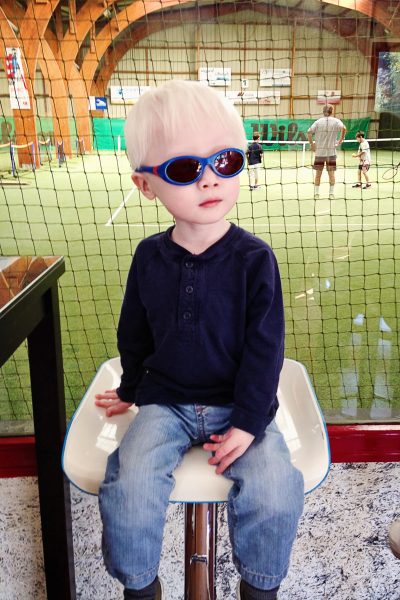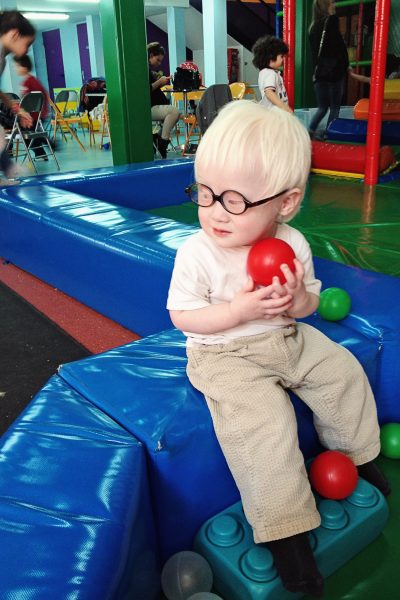No Hands But Ours is focusing on skin conditions this month. My son has albinism, but I hesitated to write our story. Heck, our dermatologist has discharged us. If my son ever has a suspicious mole or a serious burn, we’ll go back. Otherwise, I am capable of – the dermatologist pointed out – totally handling this skin condition on my own. It’s not that I have special training. For the most part, my son’s skin condition requires… nothing. Or at least nothing much different than what I already do with my four biological, fair-skinned children.
What does that entail on a daily basis?
Most mornings, I check the UV index online. There are UV monitors and even bracelets and sunscreen bottles that will change color and alert you to UV rays – but the online weather report serves just fine for us. If the UV index is below 3, then I do not think about my son’s skin for the rest of the day. Since we live quite far north, there are several months of the year when the UV index never goes above 2. If the UV index is 3 or above, then I make sure there is a bottle of sunscreen with me. If we are going to be outside for more than 10 minutes, I apply sunscreen approximately 15 minutes before we walk out the door. I only apply sunscreen on parts of my son’s body that will be exposed to sunlight – in other words, parts not covered by clothing – and I don’t apply it at all if we are mostly going to be in the car or running errands in and out of shops. When we’re outdoors, I reapply sunscreen every 90 minutes.
That’s it.
Admittedly, we’re not a big beach, sailing, Disney, etc. family. Plenty of people with albinism (PWAs) live or vacation in sunnier climates more than we do, however, without any problem. It’s simply a matter of being vigilant. UV-protective clothing and beach tents also help.
Right now, my son cannot be responsible for his own skin care, so we apply the sunscreen for him. At school, his teachers ensure that he has sunscreen as per his IEP. Happily, my son has not yet had a burn. Many PWAs have a story of a rebellious phase when they stopped being careful about sunscreen – and of one painful burn that convinced them that their parents knew best. One burn is not a disaster.
No matter what the UV index is, my son wears sunglasses and a hat with a large brim if we go out. The hat is good to protect his scalp, but mostly it is to protect his eyes. Photophobia (extreme light sensitivity) almost always accompanies albinism, and our son is no exception. We have prescription sunglasses, and also prescription indoor glasses with a 20% tint. My son is four years old and doesn’t have a lot of “self-care” skills. He learned very quickly, however, to find and put on his hat and glasses when the light is bothering him. In my humble opinion, little kids are always super cute in eyeglasses!

This month’s focus is on skin conditions, but I would be remiss if I didn’t mention that all people with albinism also have some degree of visual impairment. (I wasn’t fully aware of that when we checked “albinism” on our agency’s SN checklist, so maybe you didn’t know either!) In a nutshell: vision issues result from a lack of pigment in the retina and abnormal development of the optic nerve.
Nearly all PWAs also have nystagmus (involuntary eye movements). The degree of visual impairment varies greatly from one person to another. Our son’s visual impairment has been more of an issue than the skin condition, but that isn’t saying much.
So far, my son’s VI doesn’t really affect us on a day-to-day basis at all. Once or twice a month a wonderful teacher for the visually impaired (TVI) visits my son at home or at school. She has good tips but, honestly, it’s mostly common sense. My son is more likely to scribble (it’s “pre-literacy mark making”, people!) if he is offered chunky markers than if he’s given pencils that make faint lines. As we are teaching our son to feed himself, it’s better to spread the Cheerios on a dark-colored napkin than to camouflage them on a cheery yellow plate. When we choose board books, we look for ones with simple, uncluttered pictures. Our son is far from learning to read, but if and when he gets there (God willing), he will need enlarged type and probably a slant board and/or magnifier.
Since my son is nonverbal right now, it’s hard to determine exactly how much he can see. He is probably legally blind. That doesn’t stop him. He walks, runs and climbs as well as any four year old. Even in new surroundings, he rarely trips or bumps into anything. We think he has sonar! Chances are that he will never be able to get a driver’s license. The issue seems abstract now, but I can imagine that it is hard for a teen with albinism to watch his friends go through that rite of passage without him. Even before that stage, though, my son might be one of the kids who are embarrassed by his Elsa-white hair and insist on dying it.
As with any visible difference, there is the risk of teasing or outright bullying. On that front, our family’s experience has been relatively easy so far. People in our child’s province ranged from curious to cautious about albinism (no, it is not contagious!), but no one was unkind to us.
Now that we’re home, we’re living in a very diverse community, and people rarely even notice our son’s unique coloring. We have had some ignorant comments and questions. (Yes, his hair color is natural. No, I shouldn’t insist that he take off his sunglasses indoors. Yes, he is really Chinese!) Happily, they all seem to go right over my son’s head. Adult PWA have told me that even in the U.S. it can be hard to grow up looking different, and our family talks often about how beautiful albinism is. Most people seem to agree!

Adult PWA and other parents have been amazingly willing to share their stories and advice. Most have emphasized to me that albinism is not a handicap that will limit my son’s life in any significant way. Professional baseball might not be an attainable goal, given his VI and depth-perception issues, but albinism will not stop him from being a doctor, lawyer, marathon runner…
Please know that if you are considering adopting a child with albinism, you have a whole community of people who are ready to support and reassure you. Some resources are below.
Several types of albinism exist, including one that involves a rare bleeding disorder (Hermansky Pudlak Syndrome). Thankfully, my son has not had any unusual bruising or bleeding, and we have not done genetic testing to determine the exact type of albinism he has.
My son has white hair, white skin and blue eyes. (No, people with albinism do not have red eyes, although they may seem red in certain lighting because you can perceive the blood vessels.) It is fairly certain that he has OCA1. OCA stands for oculocutaneous albinism, meaning both my son’s eyes (that’s the « O ») and skin (the « C ») lack pigment. Children with other forms of albinism may have reddish or light brown hair, and may have some skin pigment. There are also forms of albinism that affects only the person’s eyes (OA), although that is unlikely to be diagnosed in a waiting child.
When we were reviewing our son’s adoption file, I brought it to our much-trusted pediatrician. Albinism is fairly rare – approximately one in 18,000 people in the U.S. are born with this inherited, genetic condition – but our pediatrician actually had some experience with it. He shrugged. This is not a Special Need, he told me. It’s a Social Need. Our son’s real needs, as our pediatrician wisely predicted, are all adoption-related and, sadly, go much deeper than his skin.
Resources
NOAH (the National Organization for Albinism and Hypopigmentation) has a wealth of information for parents, as well as conference calls (including some aimed specifically at adoptive parents) and an annual conference.
Albinism Community is a large Facebook group for people with albinism and their families.
Albinism Adoptive Families is a Facebook group for families who have adopted, or are in process to adopt, a child with albinism.
For families considering this special need: the Prospective Albinism Adoptive Families Facebook group is a great place to start.
“What Can I See” on YouTube is a wonderful video for understanding the VI aspect of albinism.
Love Without Boundaries also has a super video, which I watched a ridiculous number of times when I was waiting for our son.
– guest post by Jennifer

























Hi I am a 34 yr old male adult with albinism. I have spent a lot of time speaking with others with our condition and mostly all agree that they endured the same struggles in life. Bullying will most likely happen (hopefully not, but …). I recommend not trying to save or shelter your son from certain harsh realities in life. Not to say you should allow his safety to be in jeopardy but the mean kid stuff, while it was difficult at the time, strengthened me and taught me how to truly understand people. People with albinism are quite sharp, most have higher than average IQ’s as well. There is something special and unique about this condition and comes with more strengths than weaknesses if you are willing see it. Also, yes it is hard watching friends get their license while you cannot but biotic driving glasses have made a way. I have a a drivers license today but I had to wait until I was 30 to be able to get it. Lastly, raise your child like any other without the condition. Treat him like he is no different and he will grow up believing he is equal and capable. He will learn to compete in life and to figure out unique ways to do what other say he cannot. OCA is truly a blessing in disguise. God bless you in your journey.